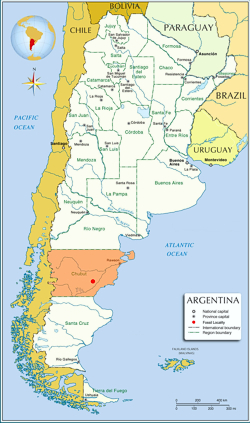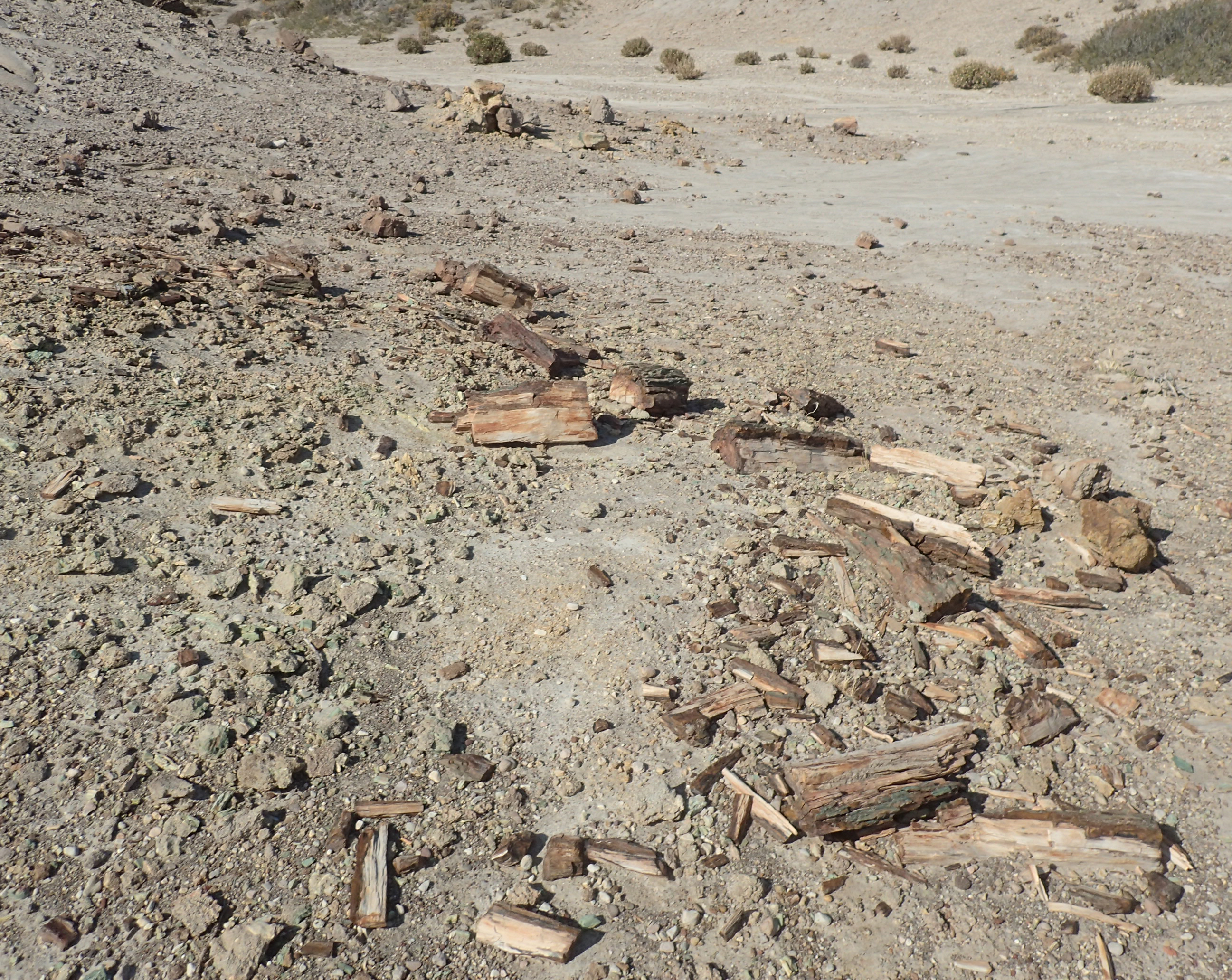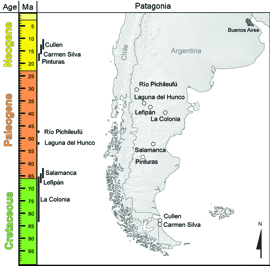 The Salamanca paleoflora, Chubut, Patagonia, Argentina includes ferns, conifer leaves and cones, leaves and reproductive organs of flowering plants (e.g., flowers, fruits, etc.), fossil pollen, and petrified wood. This flora is thought to be early Paleocene in age, or about 61.7 million years old, based on multiple lines of evidence. The plants are thought to have grown in a river-dominated environment under a relatively moist climate; the presence of cold-sensitive plants, such as palms, indicates that there was no frost in the winter. This flora is especially important because it existed shortly after the end-Cretaceous mass extinction event (65.5 million years ago), and can help us to understand how the ancient vegetation of Patagonia recovered. Many vertebrates are also known from the Salamanca Formation (the geologic unit bearing the Salamanca flora), among the most interesting of which is a species of fossil platypus.
The Salamanca paleoflora, Chubut, Patagonia, Argentina includes ferns, conifer leaves and cones, leaves and reproductive organs of flowering plants (e.g., flowers, fruits, etc.), fossil pollen, and petrified wood. This flora is thought to be early Paleocene in age, or about 61.7 million years old, based on multiple lines of evidence. The plants are thought to have grown in a river-dominated environment under a relatively moist climate; the presence of cold-sensitive plants, such as palms, indicates that there was no frost in the winter. This flora is especially important because it existed shortly after the end-Cretaceous mass extinction event (65.5 million years ago), and can help us to understand how the ancient vegetation of Patagonia recovered. Many vertebrates are also known from the Salamanca Formation (the geologic unit bearing the Salamanca flora), among the most interesting of which is a species of fossil platypus.
The Salamanca Formation provides significant information on the composition of Southern Hemisphere floras. The formation was deposited during the Danian ( Early Paleocene) following the end of the Cretaceous mass extinction event. Several taxa have been described an extinct member of the Rhamnaceae and two extinct members of Cunoniaceae based on flowers, a new species of Menispermaceae based on a fossil fruit and identified a new species of Azolla based on fertile sporophytes. There are many remaining flower morphotypes of uncertain affinity from two fossil localities, Palacio del los Loros and Rancho Grande, near the town of Sarmiento C. Some flower morphotypes have characters preserved that suggest that they belong to core-eudicot angiosperms while others have characters typical of monocots. Another locality, Estancia Las Violetas near Trelew City, also have beautifully preserved logs, seeds, and endocarps. Among them there are the southernmost record of Icacinaceae based on endocarps.
Gandolfo Lab Research

Study of the Salamanca flora is a collaborative project, with different teams of researchers taking the lead on different components. In the Gandolfo Lab, Dr. M. A. Gandolfo and others are spearheading efforts to understand the systematics of the angiosperms—or flowering plants—based on reproductive material, which in the angiosperms including flower buds, flowers, fruits, seeds, and groupings of these structures (known as inflorescences for flowers and infructescences for fruits). Often, these structures are the most important for understanding the evolutionary relationships of flowering plants, and can give important clues to their biology.
Lab Work
Much of the detailed work involved in describing and understanding species of fossil plants takes place in the lab. We employ many traditional methods of paleobotanical study, such as making observations, describing fossil species, and comparing fossil species to living plants, in order to understand the plants that we find in the field. In addition, we use modern analytical techniques to attempt to gain a more precise understanding of the evolutionary relationships of fossil and living plants.
Other Paleofloras
(Youngest-Oldest)
- Cenozoic Paleofloras
- Cullen (middle Miocene)
- Carmen Silva (Miocene)
- Pinturas (late-early Miocene)
- Río Pichileufú (early-middle Eocene)
- Laguna del Hunco (Early Eocene)
- Salamanca (early Paleocene)
- Cretaceous Paleofloras
- Lefipán (Maastrichtian- 65.5-66 myo)
- La Colonia (Campanian to Maastrichtian)
Salamanca Information
Copyright © 2020 · All Rights Reserved
